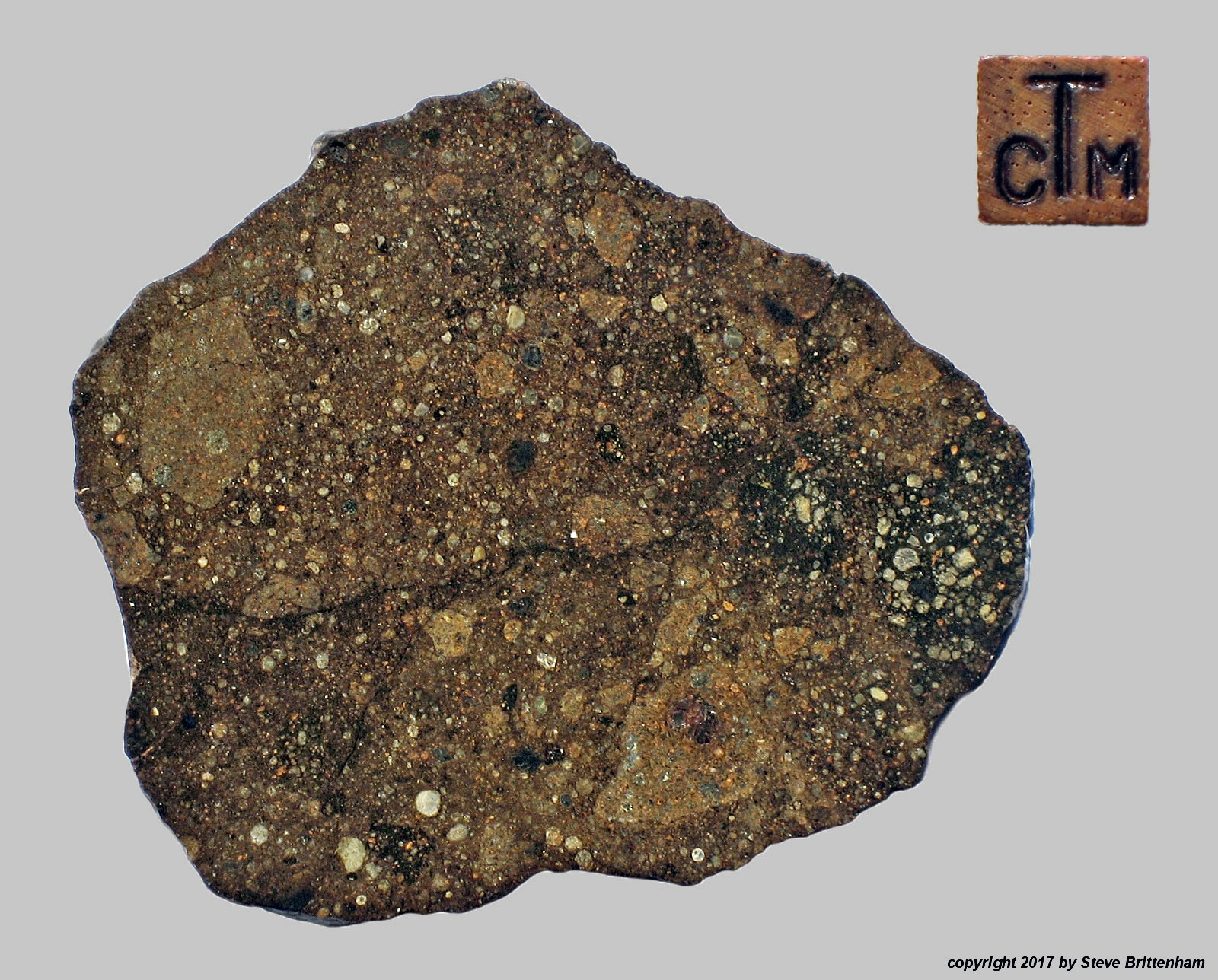|
Roll Overs:
#1
#2
#3
#4
#5
#6
|

|
|
Copyright (c) Steve Brittenham.
|
9 grams. 51 x 49 x 1 mm. R3-5
TKW 1100 grams. Fall not observed. Found 2004.
  
Steve writes:
Rumuruti (R-chondrite) meteorites are a rare group, with even fewer known
examples than Martian meteorites. Compared to ordinary chondrites, they are
more oxidized and have small but significant differences in chemical
composition and oxygen isotopes that consequently suggest they aren't
related. More than half of the R-chondrites are regolith breccias - as
inferred from signs of implanted solar wind - and analysis of noble gases in
the NWA R-chondrites suggests at least 16 different falls and a major
collision event on their parent body sometime between 15 and 25 million
years ago.
The lighter gray R-chondrites (like NWA 4288 that I previously posted on
MPOD) have been interpreted by some as being fresh, while the reddish-brown
color of ones like NWA 6491 shown here was sometimes attributed to
terrestrial sulfide alteration. But more recent findings indicate
R-chondrites formed in both dry and aqueous conditions, giving rise to their
disparate colorations. In particular, the presence of water in NWA 6491,
coupled with an appearance of fresh fusion crust and the absence of
weathering veins within its interior, suggests pre-terrestrial hydrous
alteration either on the R-chondrite parent body or in the nebular
environment.
After considering several of Bob Falls' slices of NWA 6491, I chose the 9.0
gram, 51 x 49 x 1 mm slice shown in Photo 1 because of the dark breccia on
the right that speculation at the time suggested might be possible impact
material. Later, I acquired a large thin section collection from Edwin
Thompson that included a slide from this fall. I found some of its features
intriguing and thought they might be worth sharing, though I must apologize
for the poor quality of the accompanying thin section photos (while I have a
Zeiss Ultraphot III microscope that provides crisp views through its
eyepieces, for some reason my Amscope digital microscope camera gives
distorted images; consequently these photos were taken with a Galaxy S7
cell phone using eyepiece projection).
I took Photo 2 to show the unusual bubble trains seen in the blue area (note
how some change direction); but after cropping, I noticed it looked a
little like Africa - fitting since it's an NWA! Photo 3 is a collage
showing some of the various features seen across the thin section. NWA 6491
is a breccia, and Photo 4 shows some fine-grained material that appears to
have formed or flowed around the various features (Photo 5 is a blowup of a
couple of these, the bottom half being an enlargement of the upper right
bifurcated vein in Photo 4 and a pool of this material above it). What I
found intriguing was the shearing present in some of them (one example is
seen in the lower right corner of Photo 3). Finally, Photo 6 shows an area
taken with four different rotations of polarized light; I picked it because
of the orthogonal crystalline structure in the center that was unique within
this thin section.
Click to view larger photos #1 #2 #3 #4 #5 #6
|
| |
abo zainab
8/19/2017 8:46:49 AM |
Pour ceux qui s'int*ressent
email : meteorite.zainab@gmail.com
whatsapp : +212664084944
merci |
abo zainab
8/19/2017 8:43:04 AM |
belle photo
J'ai de belles m*t*orites pour ceux qui veulent les voir ou les acheter
Je l'ai trouv* dans le d*sert du Maroc dans diff*rentes r*gions |
Michael Farmer
8/19/2017 5:28:48 AM |
I love the R chondrites |
Adri*n Contreras G*mez
8/19/2017 1:19:06 AM |
Fant*stico meteorito! Me encanta! Gracias por compartir :) |
John Hope
8/19/2017 12:20:11 AM |
Thanks very much Steve for the extremely detailed photo's of such a rare classification. Would love an example of this one. |
| |
|